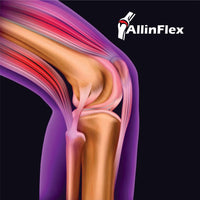Best ways to look after your Joint Health if you are an Athlete
Joints are integral components of our anatomy, allowing us to move, stretch, and display our physical power whether on a football pitch or a rugby field.
It's crucial to maintain joint health if we wish to continue enjoying sports and physical activities.
Some may overlook the importance of athlete's joints, assuming they will perform effortlessly while they focus on scoring goals or setting records. However, consider an orchestra without a conductor. Without someone to coordinate and harmonise the instruments, the resulting sound would be far from melodious.
Similarly, joints play a crucial role in athletic performance, from grasping a cricket bat to leaping over hurdles. If joint health is disregarded, there's a risk of performance deteriorating over time.
Joints can be thought of as finely tuned machinery.
The bone provides a stable structure; the cartilage offers cushioning; the synovial fluid lubricates the joint, and the ligaments and tendons hold everything together. When these components work in harmony, it enables flawless performance on the field.
However, in the realm of sports and athleticism, the road to success isn't always smooth. A minor trip or overly ambitious leap could result in joint injuries such as sprains, strains, dislocations, or even severe conditions like an ACL tear.
If you believe that resting a while will have you back in action, think again. Joint injuries can have long-term consequences on your performance. A minor injury could affect your performance, much like a flat tyre affects a bicycle's speed and stability.
Taking care of joint health is crucial not only for your current performance but also for long-term participation in sports.
The importance of preventative measures can't be overstressed. It's essential to value and care for your joints like any precious sports equipment. After all, your athletic success depends on them. Keep in mind, your body is not just a machine, but a living entity, deserving of the utmost care and respect.
Let's now explore the details of maintaining joint health for athletes
Firstly, technique and training are fundamental. Improper sports technique can put undue stress on your joints, leading to injuries. Therefore, appropriate training to perfect your technique is paramount.
Guidance from a professional coach is essential. Just as a GPS guides you on the right path, a coach can help you avoid injuries and make your journey to sports success as smooth as possible.
Warming up before exercising and cooling down afterwards are important rituals.
Warm-ups prepare your joints for the forthcoming physical activity, like an opening act at a concert. Dynamic stretches get the blood flowing and loosen up your joints. After the workout, cooling down is vital. This process brings your body back to its normal state gradually and allows for recovery. Stretches and yoga poses can help your joints remain flexible.
Nutrition also plays a crucial role in joint health.
Consuming a balanced diet that includes omega-3 fatty acids, vitamins D and C, calcium, and antioxidants can help keep your joints healthy.

Rest is another critical component for joint health. During rest, the body repairs and strengthens the joints, reducing the risk of injuries. Adequate sleep is essential for joint health. Overexerting can lead to exhaustion and injuries, so balance intense training sessions with adequate rest.
Regular health check-ups are necessary, especially for athletes, as their bodies experience frequent physical stress.
Physicians and physiotherapists can assess joint health, suggest custom exercises, and detect early signs of potential problems.
Protective sports gear is important for preventing injuries.
The right protective gear, be it knee pads for skateboarding or helmets for American football, can safeguard your joints from potential harm. It's essential to choose gear that fits well and meets safety standards. Wearing the gear correctly is also crucial.
Balance workouts can all contribute positively to your joint health:
Strength Training: This involves exercises designed to increase muscle strength and endurance. By building the muscles that support your joints, you are providing additional stability and decreasing the load on the joints themselves. For example, strengthening your leg muscles can reduce the pressure on your knee joints. Exercises such as squats, lunges, and calf raises are excellent ways to strengthen your leg muscles. Remember, it's important to learn the correct technique for strength training exercises to avoid injury.
Flexibility Exercises: These are exercises designed to enhance the range of motion of your joints. They can help maintain joint function by ensuring that the joint can move freely through its full range of motion. Yoga and Pilates are popular forms of flexibility exercises, but simple activities like stretching can also improve your flexibility. Keep in mind that flexibility exercises should be done regularly, and not just as a part of your warm-up or cool-down.
Balance Workouts: These exercises focus on improving your balance, stability, and coordination, all of which can contribute to better joint health. Balance exercises can help prevent falls and injuries, especially in sports that require a lot of quick movements or changes in direction. Simple balance exercises can be done at home, like standing on one leg, while more advanced exercises might include the use of equipment like balance boards or stability balls.Hydration is crucial for the overall function of your body, including your joints.
Drinking enough fluids helps to keep your joints lubricated, which reduces friction and helps your joints move more smoothly. Dehydration can cause your joints to become stiff and can make exercise and physical activity more challenging.
For most people, drinking plenty of water throughout the day is sufficient for proper hydration. However, if you're engaging in high-intensity workouts or activities that make you sweat profusely, you might need to drink more fluids or even consider a sports drink that can replace electrolytes lost through sweat.
If you're unsure about how much you should be drinking, a good rule of thumb is to drink half of your body weight (in pounds) in ounces of water each day. For instance, if you weigh 150 pounds, aim for 75 ounces of water a day.
Remember, maintaining your joint health is a long-term commitment that requires regular attention to training, diet, rest, protective gear, health check-ups, conditioning exercises, and hydration.
By taking care of your joints, you're not just investing in your current athletic performance but also ensuring your future in sports.






